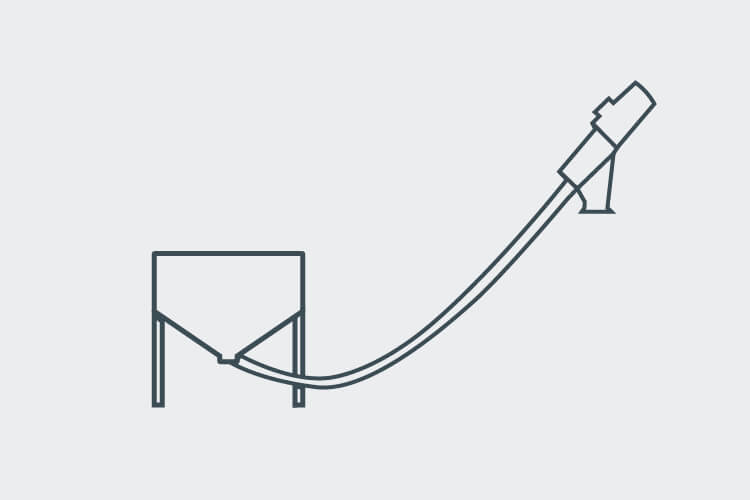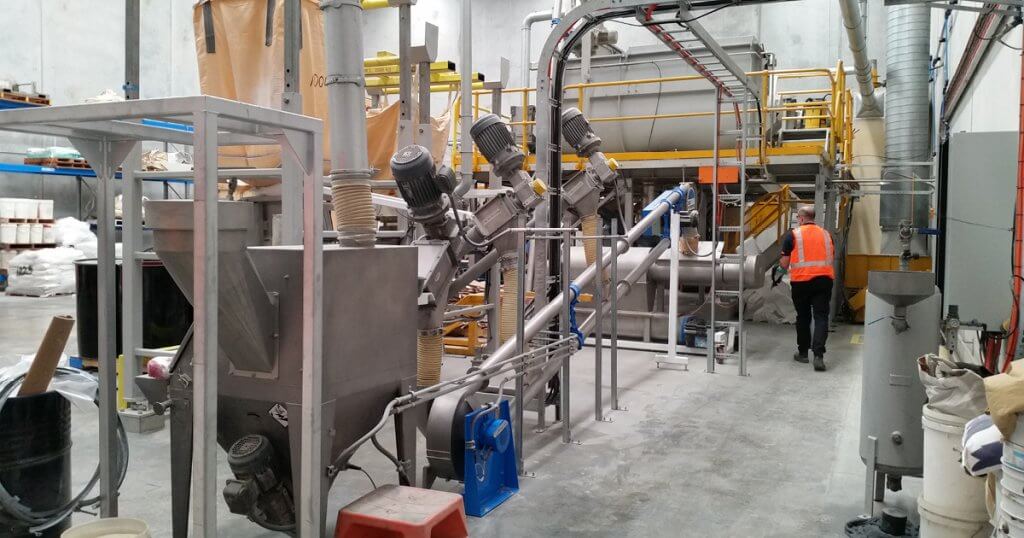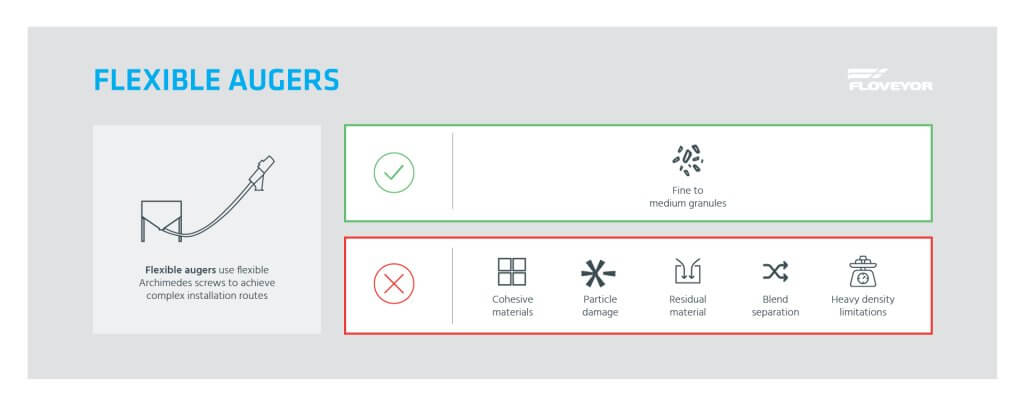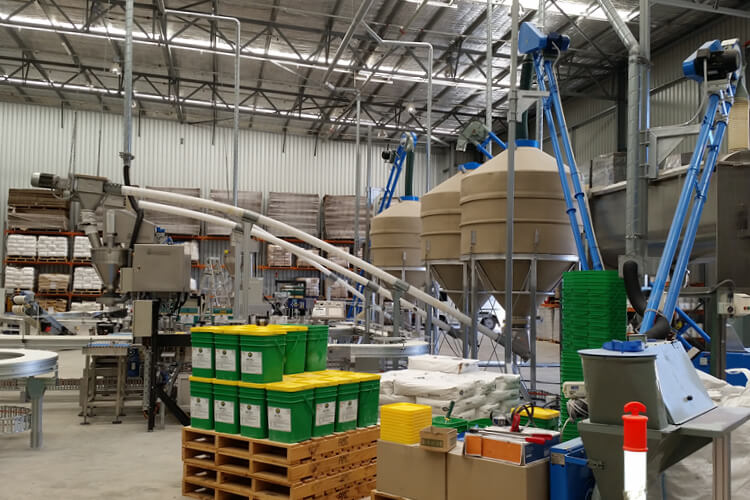Flexible augers, also known as flexible screw conveyors, have become an indispensable component in various industries. They have gained popularity in the market due to their unique design, affordable price, and capabilities and offer numerous advantages over other conveying systems. In this comprehensive guide, we will explore the features, advantages, and applications of flexible augers, along with the different models and product options available in the market.

Understanding flexible augers
At the core of a flexible auger system lies a helical or spiral-shaped screw enclosed in a flexible tube or rigid plastic casing. This screw, commonly referred to as the auger, rotates inside the tube, driven by an electric motor located at the discharge end of the conveyor enabling seamless movement of bulk material along its axis.
One of the key advantages of flexible augers is their ability to handle a wide range of bulk materials, including powders, flakes, crystals, granules, and irregular-shaped particles. This versatility makes them an ideal choice for industries dealing with diverse materials.
Features and advantages of flexible augers
When choosing a conveyor system, several factors need to be considered. These factors ensure the conveyor meets the requirements of the application and guarantees optimal performance. Here are some key considerations when choosing flexible augers:
Conveying distance
Flexible augers are often well-suited for short-distance material conveying applications. They are effective when transferring materials within a confined space or between nearby processing equipment. Their flexibility allows them to navigate around obstacles and through tight spaces, making them ideal for applications where straight-line conveyors or rigid screw conveyors may not be feasible.
Cost-effective
Compared to some other conveying systems, flexible augers can be a cost-effective solution, especially for short to medium-distance material transport. Their relatively simple design and ease of installation contribute to overall cost savings.
Multiple inlets and discharges
The flexible screw conveyor can be configured with multiple inlets and discharges, allowing for greater flexibility in material intake and distribution. This feature is particularly beneficial in applications where materials need to be transferred to multiple locations or different processing stages.
Versatility
Flexible augers are capable of handling a wide range of materials, making them suitable for both free-flowing and non-free-flowing substances. From fine powders to coarse granules, a flexible screw conveyor can efficiently convey different types of materials.
Compact design
Space constraints are a common consideration in many industries. Flexible augers are known for their compact design, allowing them to fit into tight spaces. This flexibility makes them a valuable asset in industries where space optimisation is necessary for production operations.
Ease of installation
Flexible augers are relatively easy to install and can be configured to suit various layouts. Their modular nature enables easy expansion or modification, providing flexibility for future changes in production requirements.
Ease of operation
Flexible augers are generally simple to operate. They consist of a few main components: the helical screw, flexible tube, motor, and drive mechanism. Their operation involves turning the screw to convey materials from one end of the tube to the other. Their simplicity and having minimal controls makes them easy to understand and operate.
Low maintenance
The simplicity of the flexible auger system contributes to low maintenance requirements. Regular cleaning is typically the primary maintenance task, ensuring the system remains in optimal working condition.
Customisation and adaptability
Flexible augers can be customised to suit specific material handling requirements. Whether it’s the type of screw, tube diameter, or additional features, manufacturers offer options to ensure the system meets precise needs. This adaptability makes flexible augers suitable for a wide range of applications.

Applications of flexible augers
Flexible augers find applications in various industries, including food processing, agriculture, pharmaceuticals, plastics, and more. Here are some common applications:
- Food industry: Handling ingredients, such as flour, sugar, spices, and food additives. Their gentle material handling capabilities ensure minimal damage to fragile food products, maintaining product quality and integrity.
- Chemical processing: Their ability to handle corrosive and abrasive materials makes them a reliable choice for chemical processing plants.
- Wastewater treatment: Utilised for dewatered sludge handling. They efficiently transport sludge from dewatering equipment to storage or disposal areas, improving the overall efficiency of wastewater treatment processes.
- Mining and minerals: Facilitating the transportation of ores, minerals, and other bulk materials. Their robust construction and ability to handle heavy loads make them well-suited for the demanding conditions of mining operations.
- Brewery and beverage: Breweries and beverage production facilities rely on the flexible screw conveyor for the efficient handling of grains, hops, malt, and other brewing ingredients. Flexible augers ensure precise ingredient transfer, contributing to consistent product quality.
The versatility and efficiency of these conveyors make them a preferred choice for material handling in a wide range of industries.
Types of flexible augers
Flexible augers come in various types and configurations to suit different material handling needs. Manufacturers offer a range of options to ensure optimal performance based on specific requirements. Let’s explore some common types:
Standard flexible augers
These basic, general-purpose flexible augers are designed to handle a wide range of materials. They consist of a helical screw enclosed in a flexible tube, providing efficient and reliable conveying capabilities.
Heavy-duty flexible augers
For applications that involve larger and denser materials, heavy-duty augers are the ideal choice. These augers are built with more robust components to withstand the demands of conveying heavier loads.
Flexible augers for hygienic appications
Industries such as food processing and pharmaceuticals often require strict adherence to hygiene standards. Flexible augers designed for hygienic applications are constructed with materials and features that meet these stringent requirements.
Flexible augers for abrasive materials
When dealing with abrasive materials that can wear down standard components quickly, specialised augers with wear-resistant materials come into play. They ensure durability and prolong the system’s lifespan.
Flexible augers with variable pitch
Augers with variable pitch feature different screw flight configurations along the length of the auger. This design allows for variations in conveying speed and material flow, optimising performance for specific applications.
Tapered flexible augers
Tapered augers have a changing diameter along their length. This design can be useful for applications where a controlled flow or discharge is required, ensuring precise material handling.
Tubular trough flexible augers
Some flexible augers may have a tubular trough instead of a flexible tube, providing additional support to the screw. This design is suitable for handling materials that may otherwise cause the flexible tube to collapse.
Customised flexible augers
Manufacturers often provide customisation options to tailor flexible augers to specific industry needs. This can include variations in tube diameter, screw design, and materials of construction, ensuring the system meets precise requirements.
Portable flexible augers
In industries such as agriculture and construction, where mobility is essential, portable flexible augers come into play. These systems are designed to be easily relocated or used in temporary setups, providing flexibility and convenience.
Flexible augers with quick-disconnect features
Augers with quick-disconnect features facilitate easy disassembly for cleaning, maintenance, or changes in configuration.
This feature enhances the flexibility and adaptability of the system.
The wide range of flexible auger types and configurations allows industries to choose the most suitable solution for their specific material handling needs.
Options and customisation
Construction material for flexible augers
A number of construction materials are available to suit specific applications requirement options:
- Stainless steel type 304: For good corrosion resistance and durability.
- Stainless steel type 316L: For enhanced corrosion resistance and suitable for highly corrosive environments.
- Carbon steel painted: A cost-effective option for non-corrosive applications.
Inlet hoppers
The choice of inlet hoppers can significantly impact the efficiency and functionality of a flexible screw conveyor. Various inlet hopper configurations are available, including:
- Flanged inlets: For easy connection to feed sources, such as hoppers or bulk bag dischargers.
- Standard hopper sizes: For flexibility in choosing the appropriate hopper size based on the material volume.
- Conical hoppers: For smooth material flow and preventing material bridging or clogging.
- Custom hoppers: For tailor-made solutions to meet specific material handling requirements, including dual outlets for material distribution.
Flow aids
To enhance material flow in the conveyor, various flow aid options are available, including:
- Vibrator (electric or pneumatic): Helps in loosening materials that tend to compact or stick together.
- Agitator (ribbon or paddle type): Provides additional agitation to ensure consistent material flow.
- Fluidising pad: Creates air channels within the material, reducing friction and enhancing flowability.
Level sensors
Flexible screw conveyors can be equipped with various level sensors to monitor material levels and prevent overfilling or emptying. Some of the available level sensor options include:
- Rotary paddle: Detects material presence or absence through rotation.
- Capacitive probe: Measures material levels based on changes in capacitance.
- Proximity sensor: Detects the presence of materials using proximity technology.
- Vibrating rod: Uses vibrations to detect material presence or absence.
Augers
The choice of auger design can significantly impact the material handling capabilities of a flexible screw conveyor. Different auger types can be considered, including:
- Flat wire: Suitable for handling fine powders and granules.
- Bevel edge: Ideal for cohesive materials that tend to stick together.
- Round wire: Provides versatility for handling a wide range of materials.
- Square bar: Designed for handling abrasive materials with high wear resistance.
Casings and centre cores
Flexible screw conveyors are available with different casing and center core materials, including:
- UHMW-PE (FDA-approved material): For compliance with food safety regulations.
- Stainless steel type 304 or 316L: For corrosion resistance and durability.
- Carbon steel: A cost-effective option for non-corrosive applications.
Control panels for flexible screw conveyors
You can select various control panel options to meet specific operational requirements. Some of the available control panel configurations include:
- Fixed speed: Provides a constant conveying rate for consistent material flow.
- Variable speed: Allows for adjustable conveying rates based on application needs.
- UL listing: Ensures compliance with safety standards set by Underwriters Laboratories.
- Explosion proof: Suitable for environments with potentially explosive atmospheres.
- Custom designs: Specific plant requirements may require design and manufacture of control panels tailored to specific end user requirements.
Disadvantages of flexible augers
While these type of conveyors offer numerous benefits, they do have some limitations to consider:

Duty/run time
Flexible augers are not suited to sporadic feeding as the auger needs to be ‘charged’ with materials. They rely on their ability to bend and flex to navigate around obstacles and convey materials efficiently. Extended periods of inactivity can cause the flexible components to lose their flexibility or become stiff, increasing the risk of jamming or damage during operation.
Material characteristics
Certain materials may not be suitable for handling with flexible screw conveyors due to their characteristics. Understanding the characteristics of the materials being handled is crucial. For example, very sticky, cohesive, or extremely abrasive materials might pose challenges. Factors such as flowability, moisture content, particle size, and abrasiveness play a significant role in determining the most suitable system.
Capacity
Flexible screw conveyors are typically suited for handling relatively low to moderate volumes of material. If you need to move very large quantities of material quickly, other types of conveyors might be more appropriate.
Length
The length of a flexible screw conveyor is typically limited due to the potential for sagging or excessive bending, which can affect the performance and efficiency of the conveyor.
Incline/decline
Flexible augers are generally better suited for horizontal or slightly inclined conveying applications. Steep inclines or declines may be challenging to accommodate with this type of conveyor.
Temperature
Extreme temperatures can affect the performance and longevity of flexible screw conveyors. High temperatures can cause material degradation or damage to the conveyor components, while very low temperatures can make the flexible screw less flexible and more prone to breakage.
Space limitations
Flexible screw conveyors require adequate space for installation, especially if they need to navigate around obstacles or fit into tight spaces. Evaluate the available space for the installation. Consider the dimensions and layout of the system to ensure it fits seamlessly into the designated space, optimising the overall production setup. In some cases, space constraints may limit the feasibility of using these conveyors.
Hygiene and cleanability
While flexible screw conveyors can be suitable for handling food and pharmaceutical products, they may not always meet the strict cleanliness standards required in certain industries. Cleaning these conveyors thoroughly can be challenging, especially if they have complex or hard-to-reach components.
Understanding these limitations can help in making informed decisions about the suitability of flexible augers for specific material handling applications.
Manufacturers may offer customisation options to tailor flexible augers to specific needs. Consult with the manufacturer to determine if any modifications or additional features are necessary for the system to perform optimally in your particular application.
In some cases, alternative bulk material handling systems might be more appropriate. For example, pneumatic conveyors
for long and complex routes, aero-mechanical conveyors where product separation, degradation and gentle conveyance is concerned, or screw conveyors for extreme material temperatures. The suitability of a flexible auger system largely depends on the specific material characteristics, environmental conditions, and the operational requirements of the plant.
結論
Flexible augers offer a versatile and efficient solution for transferring powders, granules, and other bulk solids. With their unique design and numerous advantages, these type of conveyors have become a preferred choice for industries seeking reliable and cost-effective bulk material handling systems. From gentle material handling to space optimisation, they provide a range of benefits that enhance productivity and ensure the smooth flow of materials. By understanding the different types and configurations and considering key factors when selecting a system, you can harness the full potential of flexible screw conveyors and optimise your material handling operations.
Consulting with powder handling specialists and thorough planning are essential for implementing the right bulk materials handling conveyor system to streamline operations and drive success.
次の粉粒体ハンドリングプロジェクトにコンベヤシステムをお考えなら、フロベヤにご連絡ください、 フロベヤにご連絡ください。.長い歴史を持つ粉体ハンドリングのスペシャリストとして、お客様の製造工場に最適なコンベヤを決定するお手伝いをいたします。


